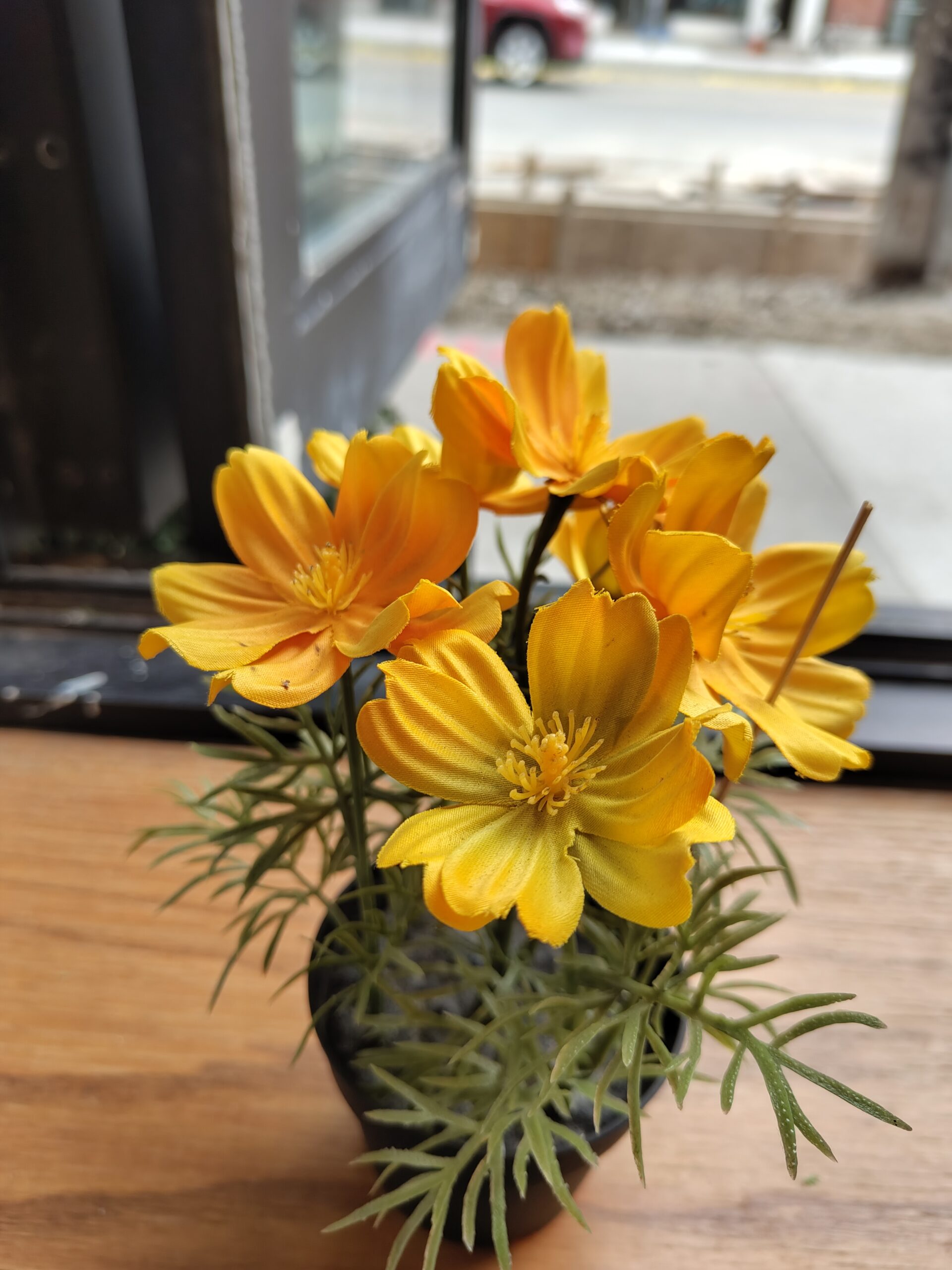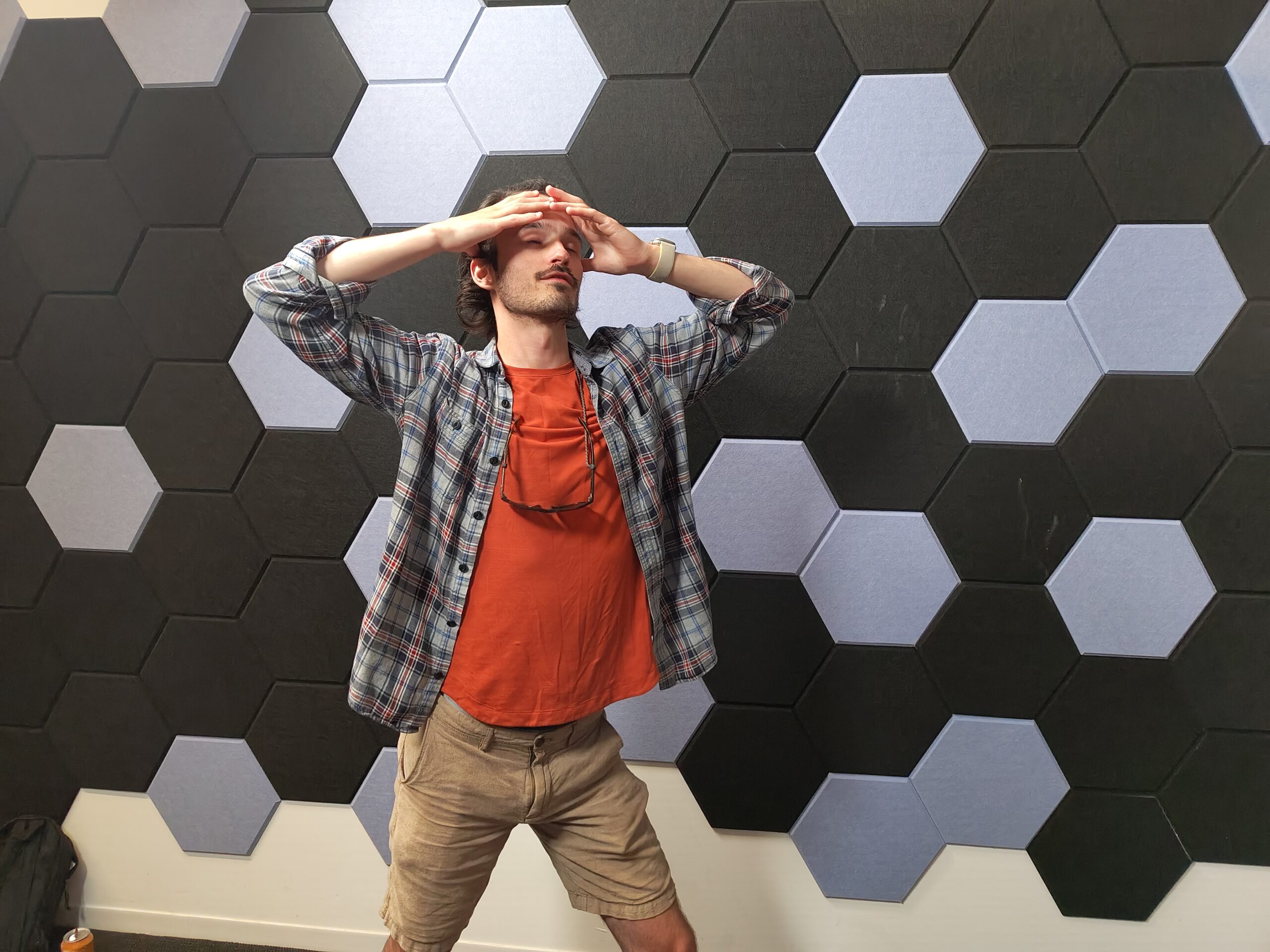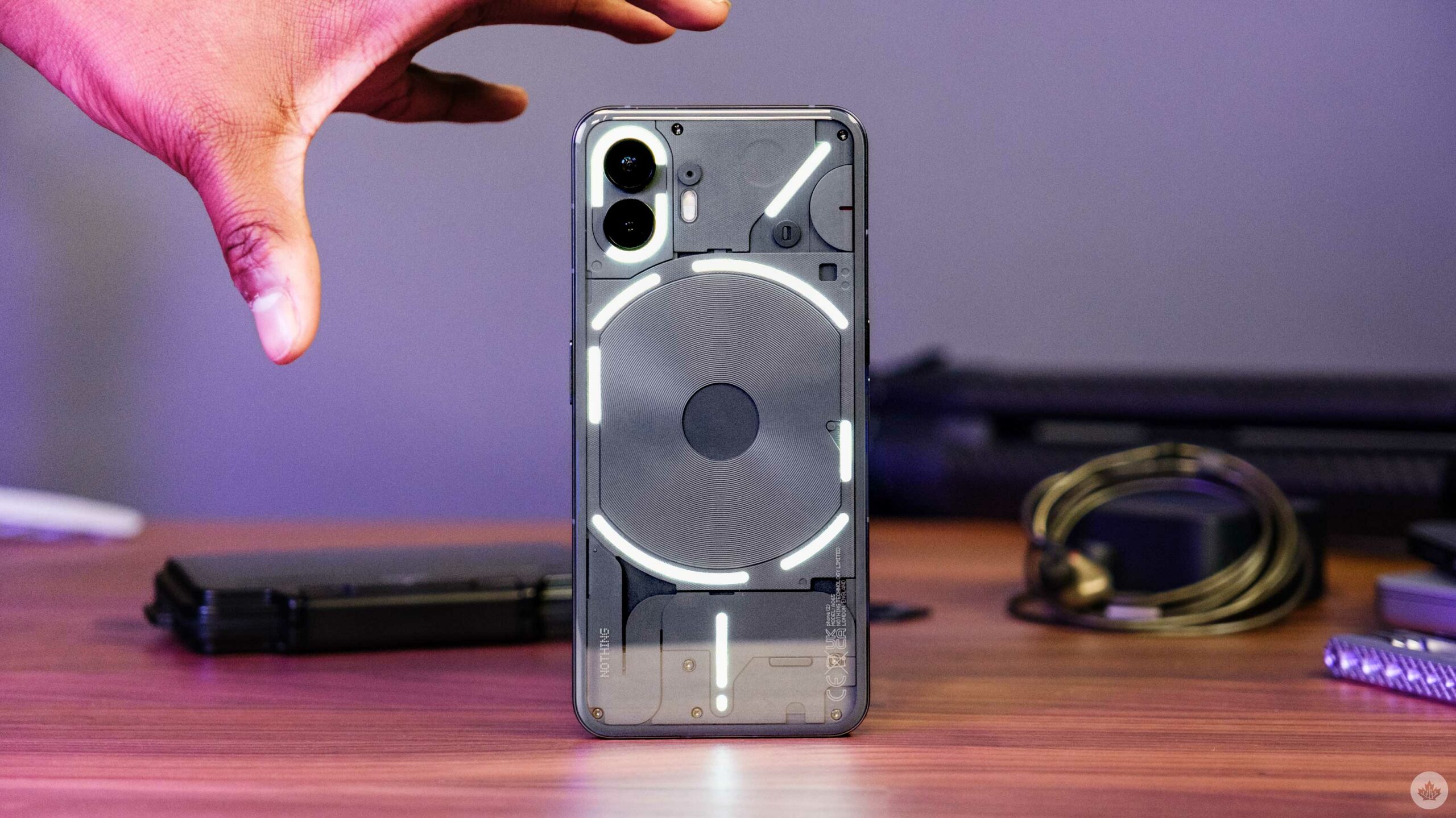
The Pros
- Good camera
- Clean Nothing OS
- Fun Glyphs
The Cons
- IP54
- Nice design, but a bit dated
- Not available in brick and mortar stores
In 2020, OnePlus co-founder Carl Pei started his own London-based company, Nothing. Since then, Nothing has released a couple of pairs of earbuds, the Nothing Phone (1) and now its latest flagship, the Nothing Phone (2).
I’ve been using the Nothing Phone (2) for the past few weeks, and the smartphone has offered a great experience overall. There are a few issues, but for the most part, I’ve enjoyed the Phone (2)’s total package.
The Nothing Phone (2) has a great design that’s easy to love, solid specs, a clean and straightforward user interface and better cameras than I expected. While I typically find simple candy bar handsets boring, the Nothing Phone (2) offers an almost iPhone-like experience that keeps me using the device daily.
Before I dive into the review, the Nothing Phone (2) price starts at $929 for the standard model with 8GB of RAM/128GB of storage, but the full spec goes up to 12GB of RAM/512GB of storage and costs $1,099. This puts the Nothing Phone (2) up against the Pixel 7 Pro (it costs $1,179 but goes on sale to below $1,000 every once in a while) and Samsung’s Galaxy S23, which costs $1,099. The Motorola Edge+, which also costs $1,099, competes with the Nothing Phone (2).
Nothing Phone (2)
Galaxy S23
Motorola Edge+ (2023)
Display
6.7-inch FHD+ LTPO OLED 120Hz HDR10+ display
6.1-inch Flat Dynamic AMOLED, 1,080 x 2,400 pixels, 20:9 aspect ratio, 120Hz display, HDR10+, 240Hz Touch Sampling in Games
6.7-inch FHD+ pOLED 165Hz display, HDR10+, Dolby Vision
Processor
Snapdragon 8+ Gen 1
Qualcomm Snapdragon 8 Gen 2
Snapdragon 8 Gen 2
RAM
8GB of RAM, 12GB of RAM
8GB of RAM
8GB of RAM
Storage
128GB, 256GB, 512GB
128GB, 256GB
256GB, 512GB
Dimensions (in.)
162.1 x 76.4 x 8.6mm
70.9 x146.3 x7.6mm
161.16 x 74 x 8.59mm
Weight
201.2 g
168g
203g
Rear Facing Camera
50-megapixel (primary) + 50-megapixel (ultrawide)
50-megapixel (f/1.8, wide) + 10-megapixel (f/2.4, 3x zoom) + 12-megapixel (f/2.2, 120-degree FOV, ultrawide)
50-megapixel (primary) + 50-megapixel (ultrawide, macro) + 12-megapixel (portrait telephoto, 2x zoom)
Front Facing Camera
32-megapixel
12-megapixel
60-megapixel
OS
Android 13
Android 13, One UI 5.1
Android 13
Battery
4,700mAh
3,900mAh
5,100mAh
Network Connectivity
LTE/5G
5G, LTE, Wi-Fi 6E
LTE/5G
Sensors
Fingerprint (in-display), accelerometor, gyro, proximity, compass
Fingerprint (in-display), accelerometor, gyro, proximity, compass
Fingerprint (in-display), accelerometor, gyro, proximity, compass
SIM Type
Nano SIM
Nano SIM, eSIM
Nano SIM
Launch Date
July 17, 2023
February 17, 2023
May 25, 2023
Misc
Colours: Gray, White, Glyph Interface
Colours: ‘Phantom Black,’ ‘Green,' 'Lavendar,' 'Creme'
Colours: Interstellar Black
Display
Nothing Phone (2)
6.7-inch FHD+ LTPO OLED 120Hz HDR10+ display
Galaxy S23
6.1-inch Flat Dynamic AMOLED, 1,080 x 2,400 pixels, 20:9 aspect ratio, 120Hz display, HDR10+, 240Hz Touch Sampling in Games
Motorola Edge+ (2023)
6.7-inch FHD+ pOLED 165Hz display, HDR10+, Dolby Vision
Processor
Nothing Phone (2)
Snapdragon 8+ Gen 1
Galaxy S23
Qualcomm Snapdragon 8 Gen 2
Motorola Edge+ (2023)
Snapdragon 8 Gen 2
RAM
Nothing Phone (2)
8GB of RAM, 12GB of RAM
Galaxy S23
8GB of RAM
Motorola Edge+ (2023)
8GB of RAM
Storage
Nothing Phone (2)
128GB, 256GB, 512GB
Galaxy S23
128GB, 256GB
Motorola Edge+ (2023)
256GB, 512GB
Dimensions (in.)
Nothing Phone (2)
162.1 x 76.4 x 8.6mm
Galaxy S23
70.9 x146.3 x7.6mm
Motorola Edge+ (2023)
161.16 x 74 x 8.59mm
Weight
Nothing Phone (2)
201.2 g
Galaxy S23
168g
Motorola Edge+ (2023)
203g
Rear Facing Camera
Nothing Phone (2)
50-megapixel (primary) + 50-megapixel (ultrawide)
Galaxy S23
50-megapixel (f/1.8, wide) + 10-megapixel (f/2.4, 3x zoom) + 12-megapixel (f/2.2, 120-degree FOV, ultrawide)
Motorola Edge+ (2023)
50-megapixel (primary) + 50-megapixel (ultrawide, macro) + 12-megapixel (portrait telephoto, 2x zoom)
Front Facing Camera
Nothing Phone (2)
32-megapixel
Galaxy S23
12-megapixel
Motorola Edge+ (2023)
60-megapixel
OS
Nothing Phone (2)
Android 13
Galaxy S23
Android 13, One UI 5.1
Motorola Edge+ (2023)
Android 13
Battery
Nothing Phone (2)
4,700mAh
Galaxy S23
3,900mAh
Motorola Edge+ (2023)
5,100mAh
Network Connectivity
Nothing Phone (2)
LTE/5G
Galaxy S23
5G, LTE, Wi-Fi 6E
Motorola Edge+ (2023)
LTE/5G
Sensors
Nothing Phone (2)
Fingerprint (in-display), accelerometor, gyro, proximity, compass
Galaxy S23
Fingerprint (in-display), accelerometor, gyro, proximity, compass
Motorola Edge+ (2023)
Fingerprint (in-display), accelerometor, gyro, proximity, compass
SIM Type
Nothing Phone (2)
Nano SIM
Galaxy S23
Nano SIM, eSIM
Motorola Edge+ (2023)
Nano SIM
Launch Date
Nothing Phone (2)
July 17, 2023
Galaxy S23
February 17, 2023
Motorola Edge+ (2023)
May 25, 2023
Misc
Nothing Phone (2)
Colours: Gray, White, Glyph Interface
Galaxy S23
Colours: ‘Phantom Black,’ ‘Green,' 'Lavendar,' 'Creme'
Motorola Edge+ (2023)
Colours: Interstellar Black
iPhone-like design
 The Nothing Phone (2) design resembles Apple’s latest and greatest iPhone hardware. The phone features a flat 6.7-inch screen, a centred hole-punch camera, and a thin midframe of 100 percent recycled aluminum. The aluminum frame is also flat, similar to my iPhone 14 Pro, and while I prefer a curved edge so it fits better in my hand, I don’t mind this either. The Nothing Phone (2) also has slightly thicker bezels than the iPhone, but the difference in size is negligible.
The Nothing Phone (2) design resembles Apple’s latest and greatest iPhone hardware. The phone features a flat 6.7-inch screen, a centred hole-punch camera, and a thin midframe of 100 percent recycled aluminum. The aluminum frame is also flat, similar to my iPhone 14 Pro, and while I prefer a curved edge so it fits better in my hand, I don’t mind this either. The Nothing Phone (2) also has slightly thicker bezels than the iPhone, but the difference in size is negligible.
However, the Phone (2) suffers from the same issue as the iPhone because both phones look outdated. The Nothing Phone (2) has a somewhat curved pillowed glass clear back with the company’s new Glyph Interface and dual camera sensors in the top right corner. I like the curved pillow glass back as it helps the handset feel a bit better when holding it.
The rear Glyph Interface features detached lights synced to flash in unique patterns that can be used for notifications and other features, but more on that later.
The Nothing Phone (2) I was sent is the ‘Gray’ model, the company’s new colour variant. I love the gray; it’s different from a simple black smartphone and looks clean. The handset also comes in ‘White.’
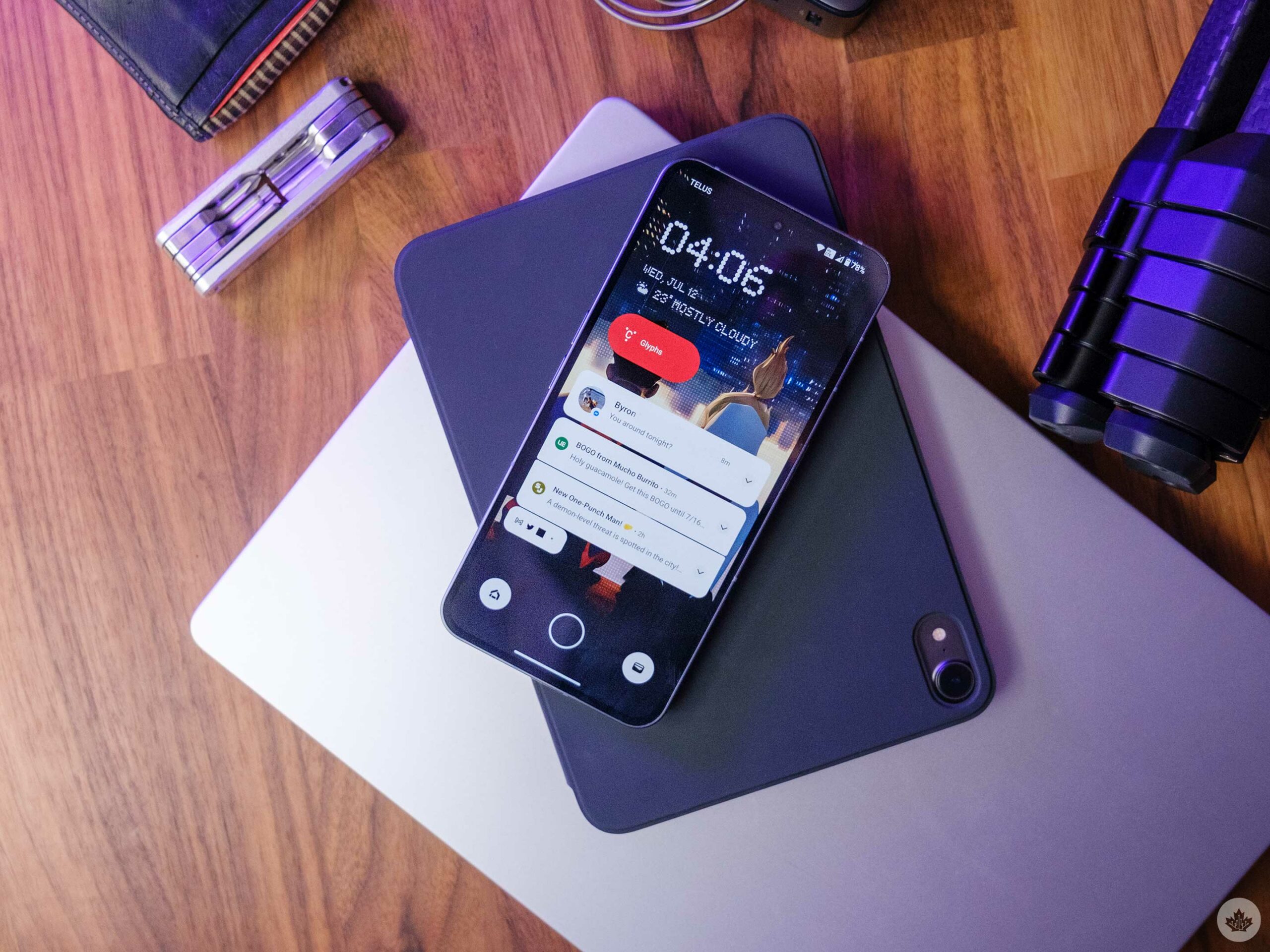 Flipping back to the display, the Nothing Phone (2) offers an FHD+ 2412 x 1080 pixel resolution that displays content wonderfully. An FHD+ resolution puts the Phone (2) in line with the S23 and the Motorola Edge+, but still behind the Pixel 7 Pro QHD+ panel. I can’t tell the difference between the resolution, however, so I’m okay with the Phone (2)’s offering. The Nothing Phone (2) has a dynamic 120Hz refresh rate, which creates a buttery smooth scrolling experience. When unnecessary, the refresh rate will drop to 1Hz.
Flipping back to the display, the Nothing Phone (2) offers an FHD+ 2412 x 1080 pixel resolution that displays content wonderfully. An FHD+ resolution puts the Phone (2) in line with the S23 and the Motorola Edge+, but still behind the Pixel 7 Pro QHD+ panel. I can’t tell the difference between the resolution, however, so I’m okay with the Phone (2)’s offering. The Nothing Phone (2) has a dynamic 120Hz refresh rate, which creates a buttery smooth scrolling experience. When unnecessary, the refresh rate will drop to 1Hz.
Further, the handset has a 240Hz touch sampling rate. A touch sample rate or touch-sensing refers to the frequency at which the smartphone tracks the movement of your finger. Typical devices offer a 60Hz touch sample rate, which tracks the screen every 16.6ms, while the latest iPhones have a 120Hz touch sample rate that cuts the time by half. The 240Hz reduces this to 4.15ms, making it feel like e the Nothing Phone (2) reacts instantly to each touch.
Combining the 120Hz refresh rate and 240Hz touch sampling creates a smooth experience; every button press feels instant. However, the very minimal Nothing OS could be partly responsible.
Gimmicks
 Nothing OS 2.0 brings a minimalistic design to Android 13, offering muted monochrome icons that add to the design language. You can also tailor everything on the device, including app labels, grid design, widget size and themes. The skin isn’t 100 percent bare, and there are differences between it and pure Android, but if you’re used to Android phones, you won’t have any issues, and it’s not too busy and very minimal.
Nothing OS 2.0 brings a minimalistic design to Android 13, offering muted monochrome icons that add to the design language. You can also tailor everything on the device, including app labels, grid design, widget size and themes. The skin isn’t 100 percent bare, and there are differences between it and pure Android, but if you’re used to Android phones, you won’t have any issues, and it’s not too busy and very minimal.
A big part of Nothing OS is the Glyph Interface. The feature includes added functionality beyond lighting up when you get a notification. For example, you see a visual indicator when you get a notification, which reminds me of the LED notifications that every smartphone used to feature. I like the visual indicator, and it’s cool you can change them and make a custom light sequence.
 Beyond the visual indicator for notifications and ringtones, the Glyphs change when you increase or decrease the volume when listening to a song when the Nothing Pohone (2) is locked. A visual indicator reacts to your voice if your handset is face down and you activate Google Assistant. Nothing says third-party integration is on the way. So far, there’s one that works with Uber, but I mostly walk everywhere or take public transit, so I haven’t seen this one yet.
Beyond the visual indicator for notifications and ringtones, the Glyphs change when you increase or decrease the volume when listening to a song when the Nothing Pohone (2) is locked. A visual indicator reacts to your voice if your handset is face down and you activate Google Assistant. Nothing says third-party integration is on the way. So far, there’s one that works with Uber, but I mostly walk everywhere or take public transit, so I haven’t seen this one yet.
I’m not delusional, Glyphs are a gimmick, but I’m someone who always loves a new gimmick, so I’m not mad at this. It’ll need more third-party integration and some added functionality, but I like it, and it’s a cool subtle feature.
Nitty Gritty
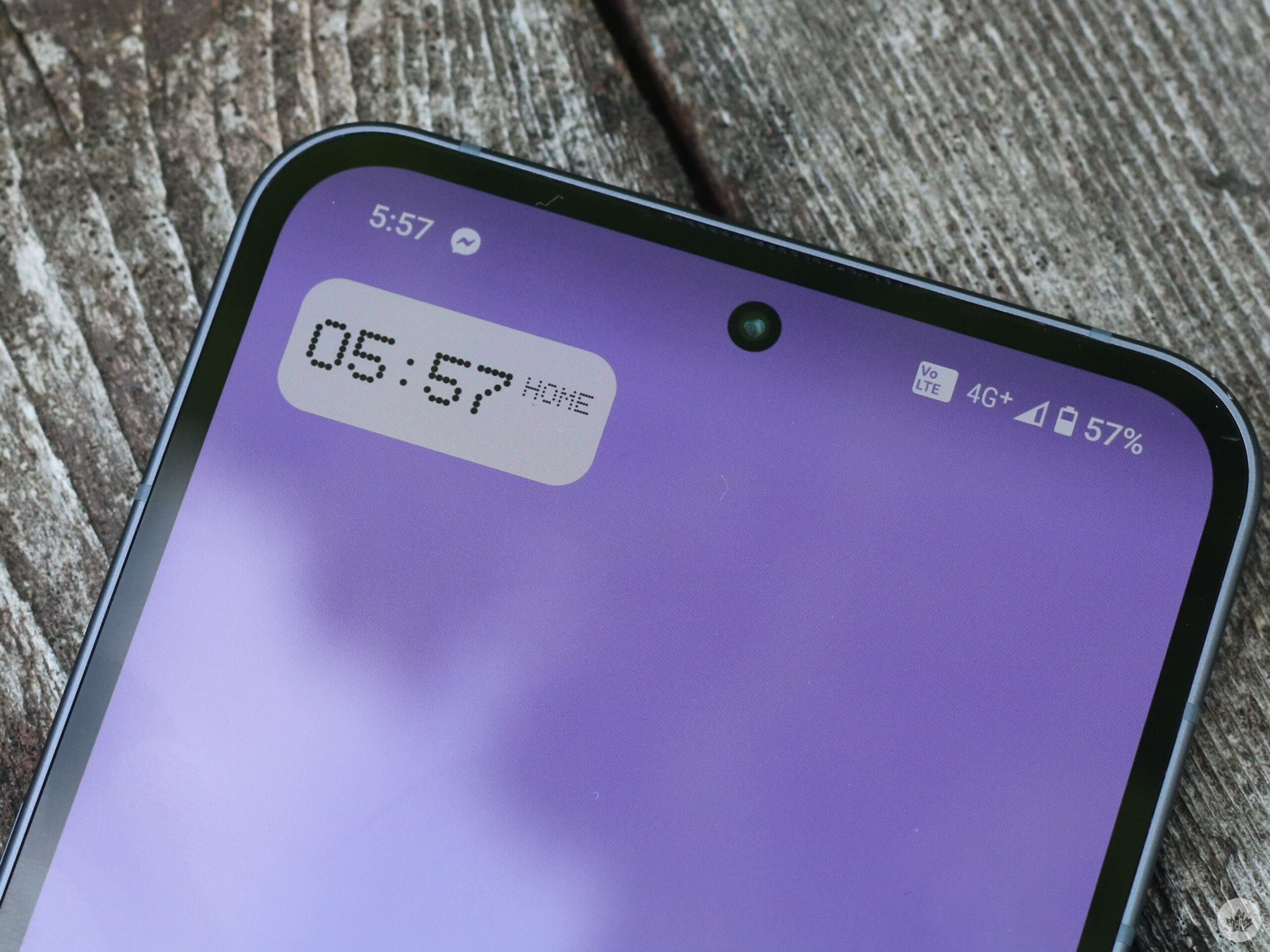
My Nothing Phone (2) model features 12GB of RAM, 512GB of storage, and a Qualcomm Snapdragon 8+ Gen 1 chipset. It’s worth noting the Snapdragon 8+ Gen 1 processor is a year old at the time of writing, which puts it behind the Motorola Edge and Galaxy S23. Both offer Snapdragon 8 Gen 2 chipsets ahead of the Pixel 7 Pro’s Tensor G2. Even though it’s running a year-old Snapdragon chipset, the phone is snappy and has no issues playing games, watching videos, scrolling through Threads or taking pictures.
At this price point, 12GB of RAM is solid and beats the Motorola Edge+ and the Galaxy S23.
I benchmarked the Phone (2) with Geekbench 6, which had a single-core score of 1,246 and a multi-core score of 4,011.
The Nothing Phone (2) has a 4,700mAh battery that keeps the phone powered throughout the day. Even when I’m taking pictures, scrolling through Threads and playing several games of Marvel Snap, I’ll end the day with about 15 percent left. This is not enough to make it through a second day, but it’s dependable, and I know that I don’t have to bring a charger around during the day. It’s also worth keeping in mind that I leave on the phone’s Always On display.

Using the Sound Meter app, I determined that music peaked at around 78 to 81 decibels, making the handset slightly quieter than the S23 Ultra. Like any other smartphone, you’ll still want to listen with headphones for a better audio experience.
The phone is weirdly IP54 water and dust resistant, which is pretty bad nowadays for a flagship device that’s not foldable. IP54 water and dust resistance means it can handle splashes, but you can’t submerge it in water, so be careful when texting on the toilet.
The Pixel 7 Pro, Motorola Edge+ and the Galaxy S23 series are all IP68 water and dustproof, which should have been the same for the Nothing Phone (2). And as someone who’ll occasionally bring my phone in the shower to more easily control my Nest Mini, I’m upset that I can’t take the Phone (2) with me.
Something Cameras
 I was pleasantly surprised by the photo quality on the Phone (2). The handset features a 50-megapixel primary shooter and a 50-megapixel ultrawide. It is a bit of a letdown that the handset lacks a telephoto shooter. Other devices of this quality have some sort of telephoto camera, and while not everyone takes distance shots, the option would have been nice.
I was pleasantly surprised by the photo quality on the Phone (2). The handset features a 50-megapixel primary shooter and a 50-megapixel ultrawide. It is a bit of a letdown that the handset lacks a telephoto shooter. Other devices of this quality have some sort of telephoto camera, and while not everyone takes distance shots, the option would have been nice.
Pictures are detailed, colours are accurate, and there’s a nice sense of contrast–further, a good range of shadows and brightness, and clear images. Sometimes background details can get lost, like blades of grass and leaves on a tree, but this doesn’t happen if it’s the focus of an image. Even without using the ‘Portrait’ mode, photos have a good sense of depth, which you can see in the shot of a dragonfly below.
The Nothing Phone (2) also surprised me with how well it takes pictures of those with a darker skin tone. My skin tone is accurate in most shots, whether the shot was taken with the primary or selfie camera. I’m also pretty happy with the selfie shooter’s ability to correctly pick up my facial hair with follicles of hair not being caught in a mess of detail.
Where the Nothing Phone (2)’s cameras falter is how it handles shots in low light. These images turn out more blurry than not and lack detailing. It also seems like the device has issues focusing at night. It’s worth noting that the camera specs on the Nothing Phone (2) are the same on paper. Still, Nothing says it’s included new AI-based technology to accurately detect a moving subject in real-time to ensure the subject is in focus.
A solid smartphone
Overall, the Nothing Phone (2) is a solid offering from the London-based phone manufacturer.
As someone who typically prefers foldables, I’ve been thrilled to use this handset. The phone uses Glyphs, which is a bit of a gimmick, but it’s still a useful feature that’s fun to show to friends. The handset also offers stellar design language, and if you like the way an iPhone 14 Pro feels, you’ll enjoy the Nothing Phone (2) as well.
The Nothing Phone (2) can handle any task I throw at it, and the Nothing OS is minimal and clean. Most importantly, the handset is reasonably priced. Unfortunately, without being available at carriers, the Nothing Phone (2) might be a tough sell. However, at $929 to start, the handset is a steal, even with its roughly year-old processor.
Some photography by Bradley Bennett.
"Overall, the Nothing Phone (2) is a solid offering from the London-based phone manufacturer"
MobileSyrup may earn a commission from purchases made via our links, which helps fund the journalism we provide free on our website. These links do not influence our editorial content. Support us here.
















